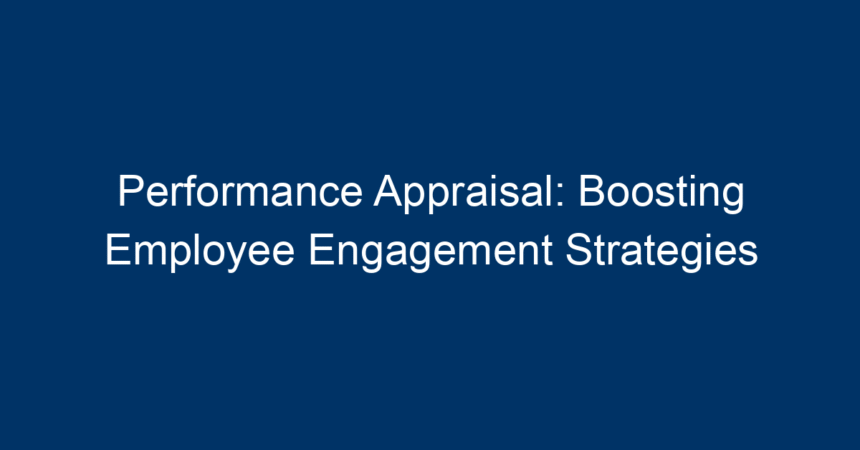In today’s fast-paced corporate world, where talent retention and employee satisfaction are more crucial than ever, performance appraisal systems are pivotal. Gone are the days when annual reviews served merely as a grading mechanism; modern performance appraisals focus on fostering employee engagement. By effectively implementing performance appraisal strategies, organizations can enhance morale, productivity, and overall workplace culture. This article delves into various methods to boost employee engagement through performance appraisals while exploring the significance of delivering meaningful feedback.
Understanding Performance Appraisal
What is Performance Appraisal?
Performance appraisal is a systematic evaluation process that assesses an employee’s job performance and productivity. This process typically involves regular reviews, feedback sessions, and performance metrics. The primary aim is to provide employees with insights regarding their performance, outline expectations, and set future goals.
The Evolution of Performance Appraisal
Traditionally, performance appraisals were focused mainly on punitive measures—pointing out weaknesses and rating employees on a numerical scale. However, organizations have gradually shifted toward a more constructive approach, emphasizing development and employee engagement. This evolution highlights a critical shift in how businesses recognize the value of their workforce, aiming for a collaborative environment rather than a merely evaluative one.
The Importance of Employee Engagement
Why Employee Engagement Matters
Employee engagement refers to the emotional commitment employees have toward their organization and its goals. Engaged employees are more productive, deliver superior customer service, and contribute positively to their work environment. According to studies, organizations with higher employee engagement levels generally see lower turnover rates and improved profitability.
The Link Between Performance Appraisal and Engagement
Performance appraisals serve as catalysts for employee engagement by offering opportunities for feedback, recognition, and growth. When executed properly, these appraisals can transform into meaningful conversations that promote trust and transparency, fostering a sense of belonging and motivation among employees.
Strategies to Enhance Employee Engagement through Performance Appraisal
1. Frequent Feedback
Ditch the Annual Review
Conducting performance appraisals only once a year can lead to outdated feedback and disengagement. Instead, adopt a culture of continuous feedback. Regular check-ins allow for real-time adjustments and foster open communication, making employees feel valued and understood.
Implement 360-Degree Feedback
A 360-degree feedback system provides employees insight from multiple perspectives, including supervisors, peers, and subordinates. This multi-faceted approach enriches the appraisal process, offering a well-rounded view of an employee’s performance and areas for improvement.
2. Goal Setting
SMART Goals
Utilize the SMART criteria—Specific, Measurable, Achievable, Relevant, and Time-bound—when setting goals during performance appraisals. Clear goal setting gives employees direction and purpose, directly contributing to their engagement levels.
Align Organizational and Personal Goals
Ensuring that employee goals align with organizational objectives enhances engagement. When employees see how their contributions impact the company’s success, they are more likely to feel a sense of ownership and commitment to their roles.
3. Create a Culture of Recognition
Celebrate Achievements
Feedback should not solely focus on areas for improvement; positive reinforcement is equally important. Recognizing achievements during performance appraisals fosters a culture of appreciation, encouraging employees to strive for excellence.
Use Rewards and Incentives
Consider implementing performance-based rewards or bonuses. Celebrating success through tangible incentives catalyzes motivation and encourages employees to engage more deeply with their work.
4. Training and Development Opportunities
Personal Development Plans
Include personalized development plans as part of the performance appraisal process. Discuss potential career paths and opportunities for training, mentorship, and further education. Showing investment in employees’ futures enhances their engagement.
Continuous Learning
Encourage a culture of continuous learning where employees feel motivated to enhance their skills. Offering workshops, seminars, and online courses shows commitment to employee growth and satisfaction.
5. Foster Open Communication
Create a Safe Space
During performance appraisals, create an atmosphere where employees feel safe discussing their thoughts and concerns. Encouraging open communication can lead to valuable insights and creates a trusting relationship between employees and management.
Active Listening
Actively listen to employee feedback, ensuring they feel heard and understood. Use these conversations as opportunities to address concerns and improve workplace dynamics.
Assessing the Impact of Performance Appraisal on Engagement
Measuring Engagement Levels
To gauge the effectiveness of performance appraisal strategies, develop metrics to measure employee engagement levels. Surveys, feedback forms, and one-on-one discussions can provide insight into employee perceptions and areas needing improvement.
Analyze Turnover Rates
Monitoring turnover rates post-implementation of new performance appraisal strategies can help assess their effectiveness. A reduction in turnover may indicate higher employee satisfaction and engagement.
Conclusion: Actionable Insights
Performance appraisal, when executed effectively, can be a powerful tool for boosting employee engagement. By transitioning from traditional yearly reviews to continuous feedback, setting aligned goals, celebrating achievements, offering development opportunities, and fostering open communication, organizations can create a thriving work culture.
Key Takeaways:
- Implement Frequent Feedback: Move away from annual reviews to continuous, real-time feedback.
- Set SMART Goals: Align employee goals with organizational objectives for increased engagement.
- Cultivate Recognition: Acknowledge achievements and provide performance-based incentives.
- Provide Development Opportunities: Invest in employee growth through training and personalized development plans.
- Foster Communication: Maintain an open-door policy for feedback and concerns.
By applying these strategies, companies can leverage performance appraisals to not only benefit their employees but also drive overall organizational success. Engaging employees means listening to them, valuing their contributions, and investing in their futures. Start today—it’s time to transform your performance appraisal system into an effective engagement strategy!




